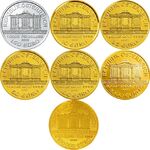m (→References: Wikipedia-en → Wikipedia-link|en (AWB)) |
m (→Description: Adding {{wp}} using AWB (code)) Tag: apiedit |
||
| (4 intermediate revisions by 2 users not shown) | |||
| Line 1: | Line 1: | ||
| + | {{Cleanup}} |
||
| ⚫ | |||
| + | {{Update}} |
||
| + | [[File:Vienna Philharmonic.jpg|thumb|150px|The Vienna Philharmonic coins]] |
||
| ⚫ | The '''Vienna Philharmonic coins''' are seven [[bullion coin|bullion]] [[coin]]s struck annually by the [[Austria]]n [[Austrian Mint|Mint]]. Six of the coins are composed of .9999 fine [[gold]], while one is made of [[silver]]. It was the best-selling coin worldwide during [[1992]], [[1995]], and [[1996]]. |
||
These coins are [[legal tender]] solely within Austria, unlike the other Austrian commemorative euro coins, which are legal tender throughout the entire [[Eurozone]]. Its bullion value surpasses its face value, and is therefore intended for collectors. |
These coins are [[legal tender]] solely within Austria, unlike the other Austrian commemorative euro coins, which are legal tender throughout the entire [[Eurozone]]. Its bullion value surpasses its face value, and is therefore intended for collectors. |
||
==Description== |
==Description== |
||
| − | All of the denominations, with an exception of the [[Austrian 1.5 euro coin|1.5 euro]] denomination, are composed of .9999 fine gold. The design for the coins was made by Austrian artist, [[Thomas Pesendorfer]]. On each coin's [[obverse]] is an image of the Golden Hall organ from the |
+ | All of the denominations, with an exception of the [[Austrian 1.5 euro coin|1.5 euro]] denomination, are composed of .9999 fine gold. The design for the coins was made by Austrian artist, [[Thomas Pesendorfer]] (1952–). On each coin's [[obverse]] is an image of the Golden Hall organ from the {{wp|en|Musikverein}}, along with the coin's value and year of minting. Displayed on each coin's [[reverse]] is a {{wp|en|cello}}, {{wp|en|harp}}, {{wp|en|bassoon}}, {{wp|en|French horn}}, and two {{wp|en|Viola|violas}} and {{wp|en|Violin|violins}}. Above this is an inscription, reading "WIENER PHILHARMONIKER". |
{| class="wikitable" style="width:100%" |
{| class="wikitable" style="width:100%" |
||
| Line 36: | Line 39: | ||
[[Category:Austrian schilling]] |
[[Category:Austrian schilling]] |
||
[[Category:Euro]] |
[[Category:Euro]] |
||
| − | [[Category:Euro coins |
+ | [[Category:Euro coins of Austria]] |
[[Category:Gold]] |
[[Category:Gold]] |
||
[[Category:Silver]] |
[[Category:Silver]] |
||
Latest revision as of 00:09, 11 March 2016

|
This article or section needs to be cleaned up to reach a higher standard of article quality.
Please follow the guidelines of our manual of style and complete this article to a higher level of quality. When this is done, this message may be removed. |

|
This page is outdated.
Please update this page to reflect recent events or newly available information. Please see the talk page for more information. |

The Vienna Philharmonic coins
The Vienna Philharmonic coins are seven bullion coins struck annually by the Austrian Mint. Six of the coins are composed of .9999 fine gold, while one is made of silver. It was the best-selling coin worldwide during 1992, 1995, and 1996.
These coins are legal tender solely within Austria, unlike the other Austrian commemorative euro coins, which are legal tender throughout the entire Eurozone. Its bullion value surpasses its face value, and is therefore intended for collectors.
Description[]
All of the denominations, with an exception of the 1.5 euro denomination, are composed of .9999 fine gold. The design for the coins was made by Austrian artist, Thomas Pesendorfer (1952–). On each coin's obverse is an image of the Golden Hall organ from the Musikverein, along with the coin's value and year of minting. Displayed on each coin's reverse is a cello, harp, bassoon, French horn, and two violas and violins. Above this is an inscription, reading "WIENER PHILHARMONIKER".
| Image | Value | Composition | Mass | Diameter | Thickness |
| €1.5 | .9999 silver | 31.103 g | 37 mm | 3.2 mm | |
| €10 | .9999 gold | 3.121 g | 16 mm | 1.2 mm | |
| €25 | 7.776 g | 22 mm | |||
| €50 | 15.552 g | 28 mm | 1.6 mm | ||
| €100 | 31.103 g | 37 mm | 2 mm | ||
| S200 | 3.121 g | 16 mm | |||
| S500 | 7.776 g | 22 mm | |||
| S1000 | 15.55 g | 28 mm | 1.6 mm | ||
| €2000/S2000 | 31.103 g | 37 mm | 2 mm | ||
| €100,000 | 31.103 kg | 370 mm | 20 mm |










